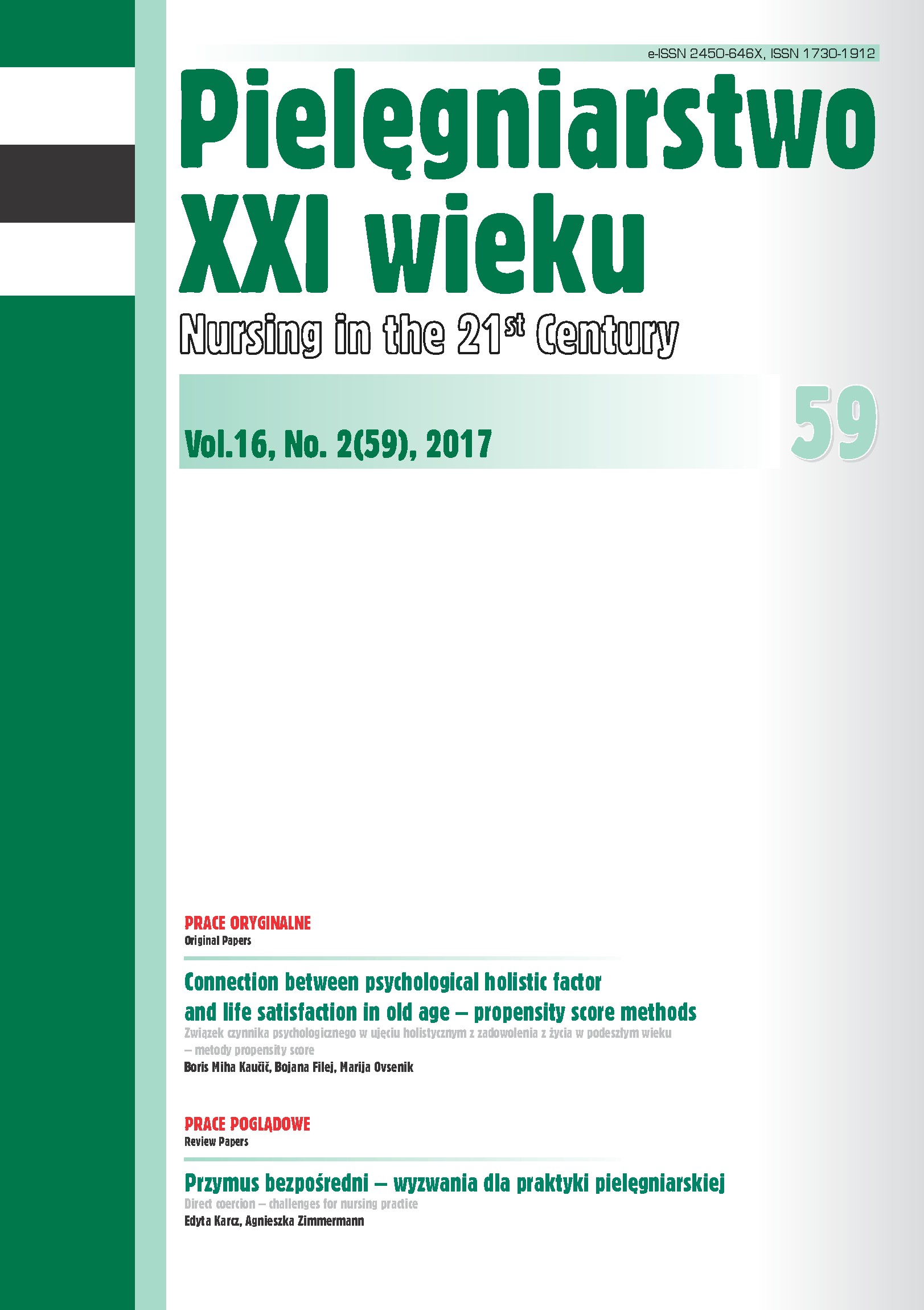Current practice in paediatric basic life support
DOI:
https://doi.org/10.1515/pielxxiw-2017-0016Keywords:
CPR guidelines, rescue breathing, chest compressions, automatic external defibrillator (AED)Abstract
CURRENT PRACTICE IN PAEDIATRIC BASIC LIFE SUPPORT
Introduction. Although the incidence of cardiac arrest in children is much lower than in adults, the condition is still considered a major health problem with a very low chance for survival. As in adults, the timely provision of cardiopulmonary resuscitation (CPR) in children is crucial. Current guidelines for CPR in children were published along with the guidelines for CPR in adults in 2015. As in previous years, they are based on consensus provided by International Liaison Committee on Resuscitation (ILCOR). Guidelines of particular ILCOR member councils may vary and reflect regional characteristic such as different access to health care, education methods or willingness of population to provide emergency assistance. Moreover, the conditions requiring CPR in children are characterized not only by different incidence, but also by aetiology or techniques used for different age groups. Therefore, emphasis is put on simplicity and feasibility as well as on consistency with adult guidelines to improve retention of the paediatric sequences. Nurses may be first rescuers not only in health care facilities. Better understanding of CPR guidelines might help them to improve their ability to detect conditions requiring CRP and also initiate and provide effective emergency care.
Aim. The aim of this study is to compare different approaches to paediatric CPR, in particular to basic life support (BLS), used in current guidelines of different ILCOR member councils.
Results and conclusions. General algorithm for adult CPR may be followed for victims of all age, but in case of children, slightly different approach might have much more favourable outcome.
References
1. Berdowski J, Berg RA, Tijssen JG, Koster RW. Global incidences of out-of-hospital cardiac arrest and survival rates: Systematic review of 67 prospective studies. Resuscitation, 2010; 81(11): 1479-1487.
2. Grasner JT, Lefering R, Koster RW, et al. EuReCa ONE-27 Nations, ONE Europe, ONE Registry: A prospective one month analysis of out-of-hospital cardiac arrest outcomes in 27 countries in Europe. Resuscitation. 2016;105: 188-195.
3. Nishiyama C, Brown SP, May S, et al. Apples to apples or apples to oranges? International variation in reporting of process and outcome of care for out-ofhospital cardiac arrest. Resuscitation. 2014; 85(11): 1599-1609.
4. Monsieurs KG, Nolan JP, Bossaert LL, et al. European Resuscitation Council Guidelines for Resuscitation 2015: Section 1. Executive summary. Resuscitation. 2015; 95: 1-80.
5. Nolan JP, Soar J, Zideman DA, et al. European Resuscitation Council Guidelines for Resuscitation 2010 Section 1. Executive summary. Resuscitation. 2010; 81(10): 1219-1276.
6. Nolan JP, Hazinski MF, Aickin R, et al. Part 1: Executive summary. 2015 International Consensus on Cardiopulmonary Resuscitation and Emergency Cardiovascular Care Science with Treatment Recommendation. Resuscitation. 2015; 95: e1-e31.
7. AHA. Highlights of the 2015 American Heart Association Guidelines. Update for CPR and ECC. [online]. 2015, Available from: https://eccguidelines.heart.org/wpcontent/uploads/2015/10/2015-AHA-Guidelines-Highlights-English.pdf.
8. Maconochie IK, Bingham R, Eich C, et al. European Resuscitation Council Guidelines for Resuscitation 2015 Section 6. Paediatric life support. Resuscitation. 2015; 95: 223-248.
9. Atkins DL, Berger S, Duff JP, et al. Part 11: Pediatric Basic Life Support and Cardiopulmonary Resuscitation Quality: 2015 American Heart Association Guidelines Update for Cardiopulmonary Resuscitation and Emergency Cardiovascular Care. Circulation. 2015; 132(18 Suppl 2): S519-525.
10. AHA. Part 11: Pediatric Basic Life Support and Cardiopulmonary Resuscitation Quality. [online]. 2015, Available from: https://eccguidelines.heart.org/index.php/circulation/cpr-ecc-guidelines-2/part-11-pediatric-basic-life-support-andcardiopulmonary-resuscitation-quality/.
11. Goto Y, Maeda T, Goto Y. Impact of dispatcher-assisted bystander cardiopulmonary resuscitation on neurological outcomes in children with out-of-hospital cardiac arrests: a prospective, nationwide, population-based cohort study. Journal of the American Heart Association. 2014; 3(3): e000499.
12. Iwami T, Kitamura T, Kawamura T, et al. Chest compression-only cardiopulmonary resuscitation for out-of-hospital cardiac arrest with public-access defibrillation: a nationwide cohort study. Circulation. 2012; 126(24): 2844-2851.
13. Iwami T, Kitamura T, Kiyohara K, Kawamura T. Dissemination of Chest Compression-Only Cardiopulmonary Resuscitation and Survival After Out-of-Hospital Cardiac Arrest. Circulation. 2015; 132(5): 415-422.
14. Kitamura T, Iwami T, Kawamura T, et al. Conventional and chest-compression-only cardiopulmonary resuscitation by bystanders for children who have out-of-hospital cardiac arrests: a prospective, nationwide, population-based cohort study. The Lancet. 2010; 375(9723): 1347-1354.
15. Maconochie IK, de Caen AR, Aickin R, et al. Part 6: Pediatric basic life support and pediatric advanced life support. 2015 International Consensus on Cardiopulmonary Resuscitation and Emergency Cardiovascular Care Science with Treatment Recommendations. Resuscitation. 2015; 95: e147-e168.
16. ANZCOR. ANZCOR Guideline 8 - Cardiopulmonary Resuscitation. [online]. 2016, Available from: https://resus.org.au/guidelines/.
17. ANZCOR. All Paediatric Advanced Life Support guidelines. [online]. 2016, Available from: http://www.nzrc.org.nz/assets/Uploads/Guidelines/Paed-ALS/All-Paed-ALSguidelines-Jan-2016.pdf.
18. ANZCOR. ANZCOR Guideline 2 - Managing an Emergency. [online]. 2016, Available from: https://resus.org.au/guidelines/.
19. ANZCOR. ANZCOR Guideline 5 – Breathing. [online]. 2016, Available from: https://resus.org.au/guidelines/.
20. ANZCOR. ANZCOR Guideline 3 - Recognition and First Aid Management of the Unconscious Person. [online]. 2016, Available from: https://resus.org.au/guidelines/.
21. ANZCOR. ANZCOR Guideline 4 – Airway. [online]. 2016, Available from: https://resus.org.au/guidelines/.
22. Lubrano R, Cecchetti C, Bellelli E, et al. Comparison of times of intervention during pediatric CPR maneuvers using ABC and CAB sequences: A randomized trial. Resuscitation. 2012; 83(12): 1473-1477.
23. Marsch S, Tschan F, Semmer NK, et al. ABC versus CAB for cardiopulmonary resuscitation: a prospective, randomized simulator-based trial. Swiss Medical Weekly. 2013; 143: w13856.
24. Deasy C, Bernard SA, Cameron P, et al. Epidemiology of paediatric out-of-hospital cardiac arrest in Melbourne, Australia. Resuscitation. 2010; 81(9): 1095-1100.
25. ANZCOR. ANZCOR Guideline 6 – Compressions. [online]. 2016, Available from: https://resus.org.au/guidelines/.
26. Sutton RM, French B, Niles DE, et al. 2010 American Heart Association recommended compression depths during pediatric in-hospital resuscitations are associated with survival. Resuscitation. 2014; 85(9): 1179-1184.
27. Maher KO, Berg RA, Lindsey CW, et al. Depth of sternal compression and intra-arterial blood pressure during CPR in infants following cardiac surgery. Resuscitation. 2009; 80(6): 662-664.
28. ANZCOR. ANZCOR Guideline 7 - Automated External Defibrillation in Basic Life Support. [online]. 2016, Available from: https://resus.org.au/guidelines/.
Published
Issue
Section
License
Copyright (c) 2017 Authors

This work is licensed under a Creative Commons Attribution-NonCommercial-NoDerivatives 3.0 Unported License.




